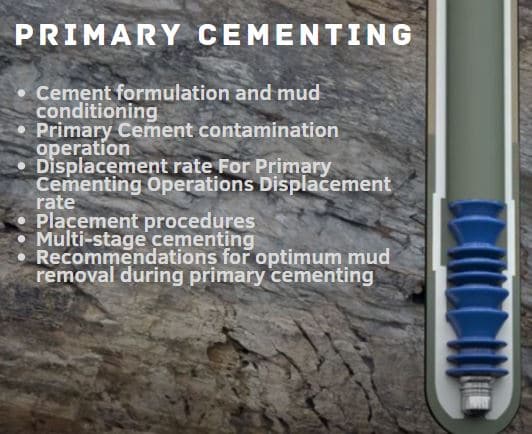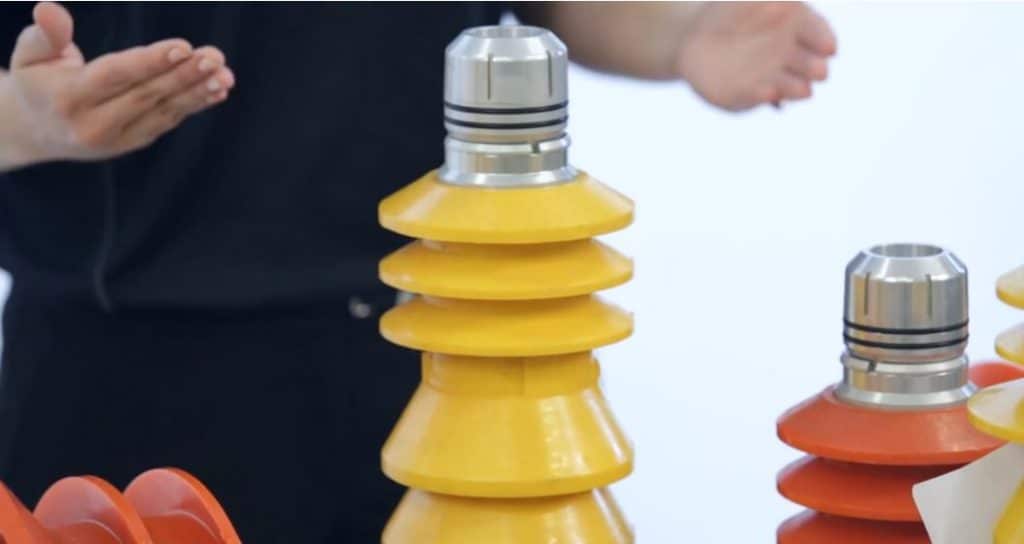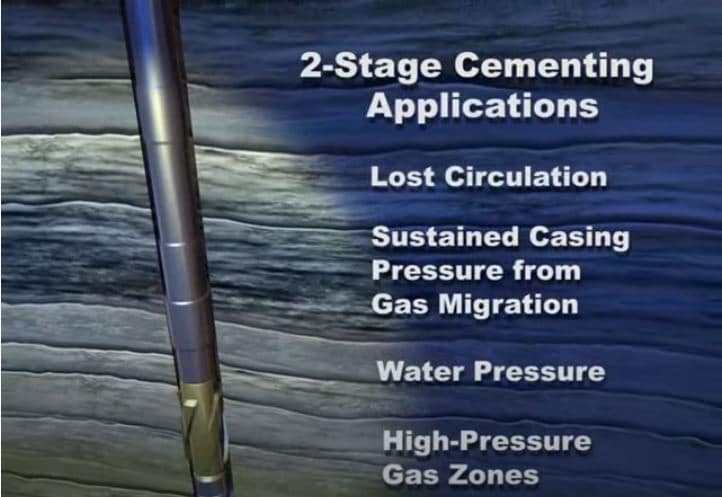In the upcoming paragraphs, we shall handle the most important factors to consider while Cementing designing, and performing successful Primary Cementing Casing operations jobs while drilling oil & gas wells (Cementing in drilling).
Cement Formulation And Mud Conditioning
To achieve a successful displacement, channeling of the cement in the annulus should be avoided which can be achieved by the following:

- The rheological properties of the cement slurry should be in relation to those of the resident fluid (mud).
- Using Turbulent Flow for removal of mud cake, or at least reduction to a minimum thickness by transmission of shear energy. Turbulent conditions can be imposed by applying a high flow rate, but also requires the cement slurry to have a low viscosity / mud gel strength.
- For a successful Primary cementing operation in drilling oil and gas wells, it is most desirable that the top of the cement column in the annulus is placed at a level which prevent higher pressure on the formation commensurate to prevent any cement loss problems. Where formation pressures are low, lowering cement gradient is the solution but note that cement strength also will be reduced.
- Conditioning Mud before Primary Cementing operation in drilling oil and gas well so that reducing rheological characteristics.
Primary Cement Contamination Operation
Contamination of cement with fluid (usually oil base or water base mud) in the well-bore will have an adverse effect on slurry properties as follows:
- The slurry will become thicker and therefore more difficult to pump.
- The setting of the slurry may be retarded when contaminated with drilling fluid that has been heavily treated with lignosulphonate thinners.
- Also the strength of the cement may suffer from contamination.
To reduce contamination risks and increase displacement efficiency it is necessary to separate the cement from the original hole/casing contents. This can be achieved by using one or all of the following:

- physical means (top and bottom plugs inside casing or casing liner (One of Types Of Casing))
- spacers or pre-flushes.
- Scavenger slurries
- chemical washes.
Displacement Rate For Primary Cementing Operations Displacement Rate
It has been indicated above already that efficient mud and -cake removal requires cement to be pumped at the highest possible rate, i.e. 80 m/minute or better, to attain turbulent conditions for more efficient primary cementing operation in any drilling oil and gas well. However, high pumping rates are accompanied by high equivalent circulating densities (ECD), the incremental gradient derived from friction losses.
High ECDs carry a risk of inadvertently exceeding maximum allowable pressure opposite weak formations, causing fracturing or inducing losses (check our lost calculational full guide). This is particularly true for the primary cementing operations job of long strings with narrow annular clearance. Reducing the cement (and supernatant drilling fluid) rheology to a minimum for a stable fluid will result in a lower ECD for a given pump rate. Pumping in plug flow, i.e. 20 m/minute or lower, is strongly discouraged.
Primary Cementing Placement Procedures
To get the cement at the desired location several placement techniques can be employed :
- The ‘normal‘ technique where cement is pumped down the casing between plugs, is circulated around the shoe and up in the annulus.
- ‘Stab in‘ or inner string primary cementing operations job for large casing sizes. The cement is pumped down a drill string stabbed into the float shoe.
- Liner cementing too is performed with the aid of a drill string attached via a running tool to the pipe for running, and pumping slurry down.
- Reverse circulation cementing for weak formations. The cement is pumped down the annulus, the displaced mud is flowing up in the casing.
- Outside or annulus cementing (‘grouting’), particularly of larger pipe sizes, through tubing or hoses.
- Delayed setting cement placement in the well-bore before running casing.
- Primary Multistage cementing in casing to avoid exceeding fracture gradients.
Multi-Stage Cementing In Casing

The overpressures from a primary cementing column in the casing annulus, particularly for long strings, maybe too high for the formation, and as a result losses and/or fracturing may be induced and the top of cement will not reach its objective. This situation may be avoided by using one of the following techniques:
- Lighter cement slurry (having also a lower compressive strength).
- Carry out the cementing operation in two or more stages. Special equipment is needed to be able to carry out such multi-stage cementing.
Recommendations for Optimum Mud Removal During Primary Cementing
While Drilling
Try to avoid as much as possible the creation of wash-outs while drilling.
While Casing Running
Optimum Casing centralization in the open hole section should aim for at least 70%.
Before Cementing Casing
- Before start of the Primary cement job operations, condition the mud to at least the original specifications, bringing down mud PV to about 30 mPa.s and YP to about 10. Gel strength of the mud should be as low as possible and not progressive. Circulate a minimum of two hole volumes of mud at a high rate (80 m/min annular velocity or more), to break gels in the hole and make partially dehydrated mud mobile. To prevent gels building again, restrict idle time between mud circulation and pumping the cement preflush to a maximum of 10 minutes.
- Total pre-flush volume: at least 150 m annular height; more than 300 m has little additional beneficial effect. Preflush can be split up in spacer and scavenger.
- Spacer: Aqueous spacers work as well as more sophisticated formulations and are cheap. Unless well control calls for weighted spacers, water spacers are preferred. A surfactant can be included to make the spacer compatible with oil-based mud. Use of a thinned cement slurry as a scavenger optimizes mud displacement. The scavenger slurry typically is a dilatant fluid, i.e. has a power law coefficient n > 1. It will not be stable under static conditions, so it should not have a zonal isolation function.
- The main cement slurry should be stable and have a power law coefficient n of about 0.9. The density should be as required for well control or for avoiding losses.
While Cementing Casing
- In primary cementing, the cement should be displaced into the annulus with as high a displacement rate as possible, with a minimum of 80 m/min annular velocity.
- The contact time of the flowing cement slurry in sections where a seal is required should be at least 5, preferably 10 or more, minutes at high displacement rate.
- Movement of the pipe, either reciprocation or rotation, should be applied.
Limiting Gas Migration In Cement
In general, the measures that can be taken to avoid gas migration in cement is to design for the best possible, 100% mud removal efficiency by adhering to good cementing practices as follows:
- Ensure full pressure control during the entire cementing process.
- Use a formulation that yields set cement of sufficiently low permeability.
- Avoid pressure/temperature cycling in the casing after the cement has set. Mechanical seal rings can be used to close off possible micro-annuli at the cement/pipe interface
Thank you for every other informative blog.